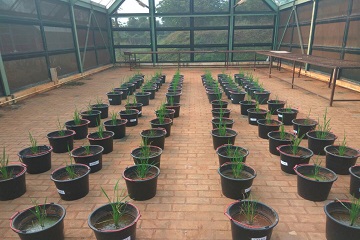Students of IPB Discover Fertilization Function in Volcanic Rocks

The role of a piece of farmland is very important for the fulfillment of the human needs for food. Land is a place to grow various sources of human food. Bogor Agricultural University’s (IPB) researchers identifies the problem on paddy fields of a declined quality because of the cultivation activity that has caused the loss of silica from the land, with no effort of improvement.
Silica itself is mostly found in the parts of rice plants such as husk and rice straw, but both of which are thrown away after the harvest. The problem is the use of silica for fertilization is not common in traditional farming, one of the causes is the unaffordable price of silica fertilizer. Soil improvement by returning the waste of the harvest to the soil also has many obstacles because its need coincides with other purposes such as animal farming. A study by Chandra Padang, Imelda Kusuma Wardani, Engge Mustamei, and Annisa Veradias Nasuta in the Student Creativity Program Team (PKM-P) of Research raised the importance of providing silica elements in paddy fields through a fertilization method.
A literary study by the team found that there is a substance from a volcanic rock area called Tress that can replace the role of silica fertilizer. It is formed through the weathering of volcanic rocks containing silica and calcium; when put together by lime tohor and water, they turn into a material like cement. Tress is also referred to as ameliorant or soil fertility enhancer. So far tress has not been widely utilized, and cannot be obtained from a commercial store. Utilization of tress is still marginal, only from the volcanic area
This study began by taking soil material from various sources. There are two kinds of tress treatment: burned and unburned. The technique of rice cultivation applied is not different from the existing cultivation techniques. Soil processing, weed control, and fertilization applied were the existing standard cultivation techniques. Tress was given to the paddy field before the rice was planted. In this study, rice was grown in a container or a bucket. Tress that has been prepared and measured according to the dosage was mixed with the soil before the water inundation. The waiting period for tress to mix with the soil in this study was one week before the soil is cultivated.
The study is conducted in IPB’s Experimental Garden of Dramaga, that is, inside the greenhouse. It takes about five months from preparation until the rice harvest. Rice will be observed for its growth and compared with those without giving Tress. The yield will be evaluated to determine the effect of added tress as well as the dose that gives the best results.
It is expected from this research that there will be further development of knowledge about the use of tress as a useful material for agriculture. The improvement of the community knowledge on how to improve the soil adding silica to the rice fields to keep a good rice productivity. A good quality of agricultural land will certainly make the rice yield remain stable for a long time and able to meet the national food needs. (Mtd)



